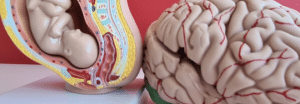
A recently published study by researchers at Emory University, the University of North Carolina at Chapel Hill and Columbia University has found that a mother’s exposure to phthalates during pregnancy can affect her newborn’s metabolism and brain development. The study was published in Nature Communications.
Key Findings About Phthalates
Phthalates are a group of widely used plasticizers, often found in a wide variety of cosmetic and personal care products such as shampoos, soaps and detergents, as well as in plastic food and drink containers. Previous research has shown that phthalates may have hormonal effects and may be associated with health effects in mothers and babies.
- Prenatal levels of phthalates in the mother’s blood during pregnancy have been associated with lower levels of important neurotransmitter precursors (related to tyrosine and tryptophan metabolism) in the blood of the newborn shortly after birth, which are important for brain development.
- Higher prenatal phthalate levels were also associated with biological changes related to lower levels of information processing (or attention) and excitability (or arousal) in newborns.
- These findings suggest that a mother’s phthalate exposure during pregnancy can affect her newborn’s metabolism shortly after birth. Furthermore, babies’ phthalate exposure while still in the womb may also have lasting effects on infant brain development.
“This was the first study to show that a mother’s phthalate exposure can affect her baby’s metabolome, and the first to show that these biological changes can affect the newborn’s development. This is important because it is generally assumed that the placenta protects the baby from many harmful substances. However, this study demonstrates that phthalates cross the placenta and can affect the biology of the baby before birth and negatively impact development over time,” said Susan Hoffman, PhD, the study’s first author and a graduate of the Epidemiology PhD program at the Rollins School of Public Health.
Study Links Prenatal Phthalate Exposure to Altered Information Processing in Infants
Previous research studies have found evidence that pregnant women’s exposure to phthalates is associated with altered cognitive outcomes in their infants. Most of the findings involved slower information processing in infants with higher levels of phthalate exposure, with more of an effect on boys depending on the chemical and the order of the information presented to the infants. Researchers at the University of Illinois at Urbana-Champaign analyzed metabolites of three common phthalates in urine samples collected regularly from the pregnant women in their study. The chemical exposure data were used in combination with assessments of the women’s infants when the children were 7.5 months old. The researchers used a proven method that provides insights into the minds of children who are too young to express themselves verbally: infants typically look longer at unfamiliar or unexpected images or events.

The team used an infrared eye tracker to follow each child’s gaze during several lab trials. With the child sitting on a caregiver’s lap, researchers first familiarized the child with two identical images of a face. After the child learned to recognize the face, researchers presented the same face along with an unfamiliar one. In repeated trials, half of the 244 infants tested came to recognize one set of faces as familiar, and the other half learned to recognize a different set of faces as familiar. By analyzing the time the infants spent looking at the faces, the experts were able to determine both the speed with which the infants processed new information and to assess their ability to pay attention.
The assessment linked pregnant women’s exposure to most of the phthalates studied to slower information processing in their children, but the result varied depending on the specific chemical, the sex of the child, and which faces the child viewed as familiar. In particular, male children tended to process information more slowly when their mothers were exposed to higher levels of phthalates, which are known to disrupt androgenic hormones.
The specific features of the faces presented to the infants in the habituation trials also appeared to play a role in the outcome, the researchers reported. Phthalate-exposed children who were first familiarized with faces from set 2 were more likely to show slower processing speed than children who were familiarized with faces from set 1. The result is confusing, but probably related to differences in infants’ preferences for the faces in the two sets. It could also be an indication that familiarization with the faces from set 2 is a more sensitive indicator of changes in processing speed associated with phthalate exposure.


